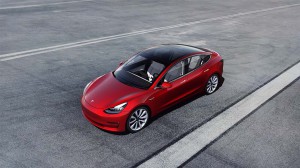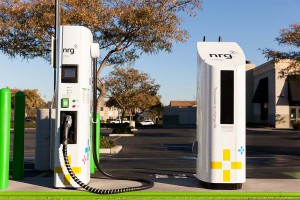
The Tesla Model 3 can now be charged at third-party charging stations with the use of a $450 adapter, like the Model S and Model X.
Tesla Model 3 owners now have a choice, at least when it comes to charging their vehicles. After making its mainstream vehicle only chargeable using the company’s Supercharging network, Tesla’s allowing Model 3 owners to also use CHAdeMO adapters too.
However, the news isn’t as electrifying as it appears on the surface. The CHAdeMO adapters, which cost $450 and have been available for Model S and Model X for some time now, do give Tesla Model 3 owners more options, but they aren’t as widely available as CCS connectors and nor are they as fast.
The third-party DC chargers are limited to 50kW compared to 150kW max for a Supercharger. The CCS charger plug is in use for Model 3 in Europe as that is the most popular there as well. However, the Model 3 is just being shipped to Japan and CHAdeMO is more popular there.
Regardless of what adapter the Model 3 can use at third-party charging stations, at least one company is happy to have them as customers.
(CEO Musk Says Teslas are Going to be Much Pricier in the Future)
“EVgo is thrilled to welcome Tesla Model 3 drivers to EVgo’s fast charging network, the largest and most reliable in the nation,” said Cathy Zoi, CEO of EVgo.
“EVgo invites all Tesla drivers to use their CHAdeMO adapter at any one of EVgo’s more than 1,200 fast chargers conveniently located in 66 cities across the country.”
It should be noted that in most cases, Tesla’s Superchargers are going to be less pricey than the DC chargers at other places like the aforementioned EVgo or ChargePoint or Electrify America. Non-Tesla spots usually require a subscription as well.
(Tesla Sets New Production, Sales Records in Q2)
The expanded availability of chargers is good news, but it may not be all sunshine and roses in the EV maker’s Palo Alto, California headquarters. A report from Ars Technica suggests the company’s Autopilot development team is losing employees.
“At least 11 members of the software team, or close to 10% of the total group, including some longtime members, departed in the past few months,” Amir Efrati of The Information website writes. “These departures follow Mr. Musk’s removal of the Autopilot group’s leader Stuart Bowers around the start of May.”
While Musk has been touting the availability of a ready-in-2020 Autopilot publicly, privately he’s unhappy that the company may not meet that deadline. Musk told subordinates that “he was unhappy with the progress in developing fully automated driving capabilities. He is also upset that some team members have told him they can’t meet the timelines he has set for developing the technology,” according to sources who talked to Efrati.
(Tesla stock rebounds, but questions remain about production)
Musk wants Autopilot to be proficient in city driving, handling traffic lights, roundabouts, and other complex intersections in the near term. He expects Autopilot will be capable of handling all types of roads and intersections with driver supervision by the end of the year. After that, full autonomy will take no more than another year, according to Ars Technica.

